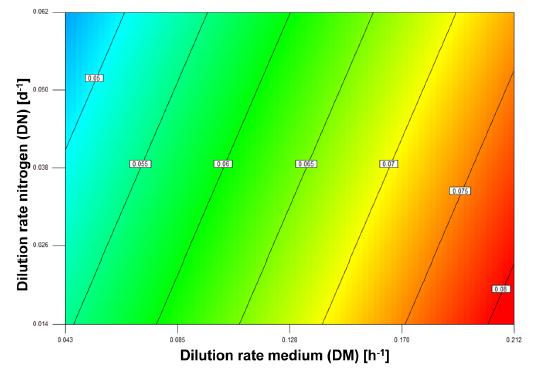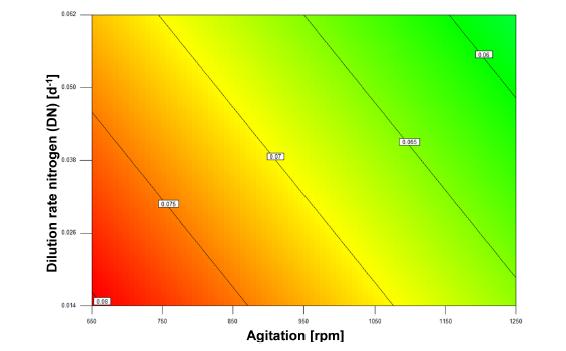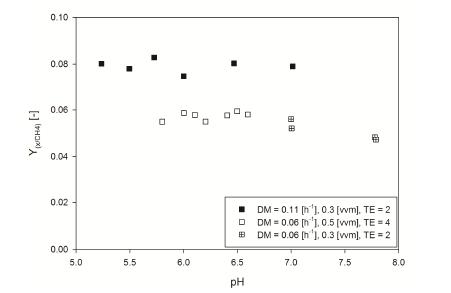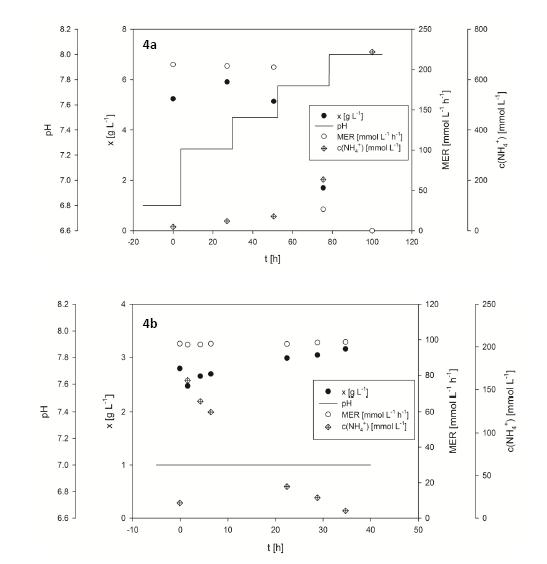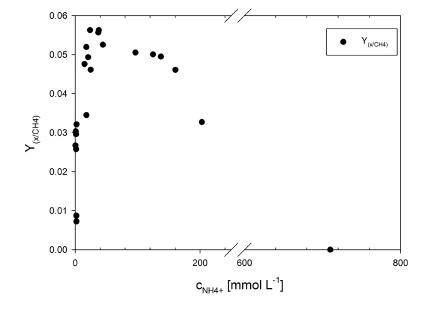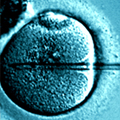Abbreviations list:
C-mol = moles of carbon; CNH4+ Ammonium concentration (mmol L-1); D = dilution rate (h-1); DM = Basal Medium Dilution rate (h-1); DN = Nitrogen Dilution rate (d-1); DoE = Design of Experiments; DoR = Degree of Reduction; DS = Sulphide Dilution rate (d-1); MER = Methane Evolution Rate (mmol L-1 h-1); MLR = Multiple Linear Regression; qCH4 = Specific methane productivity (mmol g-1 h-1); qCH4, max = Maximum specific methane productivity (mmol g-1 h-1); rpm = Revolutions per minute; rx = Biomass production rate (C-mmol L-1 h-1); TE = Concentration of trace elements in DM; vvm = Volume of gas per volume of liquid per minute (L L-1 min-1); Y(x/CH4) = Growth to product yield (C-mol mol-1); x = Biomass concentration (dry cell weight) (g L-1).
1. Introduction
A new generation of biofuels is required to produce energy carriers targeting carbon dioxide(CO2)neutrality. The chemical storage of electric energy generated from renewable resources in the form of methane(CH4)transforming molecular hydrogen(H2)to CH4 by CO2 fixation is a topic which emerged as the storage of H2 at an appropriate energy density is difficult [1]. This storage concept is also known as “Power to Gas” and received much attention because peaks of irregularly generated renewable energies could be stored as CH4. Hydrogenotrophic and autotrophic methanogens from the Archaea life domain seem to be very promising c and idates for the development of biological gas conversion processes. They benefit of a fast metabolism as well as a tolerance towards toxic compounds [2]. Additionally, these microorganisms grow autotrophically by assimilating CO2 as carbon and energy source while reducing it with H2 [3,4]. Furthermore, high volumetric productivities up to 950 mmol L-1 hr-1 and the here proposed process description are reported in recent literature [5,6]. Hence, the potential greenhouse gas CO2 could be recycled biologically producing CH4 through a biological methane production(BMP)process [2,3,7]. This would enable a concomitant power storage and CO2 utilization.
Several hydrogenotrophic and methanogenic strains have already been investigated in fed-batch and chemostat cultures for elucidation of biological parameters. The behavior of gas limited cultures was also described [8,9,10,11]. High volumetric productivities as well as efficient conversion of CO2 to CH4 were reported [5,9,10]. However, literature indicated that the ratio biomass production rate(rx)to methane evolution rate(MER), which denotes the ratio of growth to product yield(Y(x/CH4))is affected by several parameters. This variation was often reported for methanogens growing on different H2 and CO2 gassing rates [9,10,11,12,13,14,15,16,17,18,19,20,21] as well as under phosphorous limitation [22].
Variations in Y(x/CH4) suggests variation from rx rather than MER as the latter is compensated by the high maximum specific methane productivity(qCH4, max)per gram of biomass [23]. These variations needs to be closely investigated in order to develop a scalable feeding strategy for an industrial BMP process which needs to run stable in continuous and discontinuous operation modes. It is of interest to identify how Y(x/CH4) varies for two main reasons. First, identifying parameters to apply at chemostat cultures to have a stable Y(x/CH4) is important for controlling the metabolic state in media development tasks. Secondly, the possibility of controlling Y(x/CH4) would enable to tune the carbon flux of the process as it reflects the observed selectivity for the carbon transformation towards the products of reaction, biomass and CH4.
The goal of the experimental endeavor was therefore to propose a combination of methods consisting of multivariate chemostat cultures(with controlled input factors) and dynamic experiments which targeted to reveal and rapidly quantify the influence of main process parameters on Y(x/CH4). For this investigation, Methanothermobacter marburgensis, a hydrogenotrophic, thermophilic and methanogenic microorganism was used. The physiology and CH4 productivity was already the topic of many investigations [5,6,17,18,23,24]. In order to investigate the relevant culture parameters influencing Y(x/CH4) a combination of multivariate screening design of experiment(DoE) and dynamic experiments was applied. Multivariate screenings and optimization designs of experiment have already been applied in bioprocess developments and investigations [28,29,30] and likewise have dynamic experiments been used for the investigation of microorganisms [31]. However, studies applying dynamic experiments for investigation of hydrogenotrophic methanogens are very rare [23]. A combination of both methods has not been reported yet. Up to now, no model organism and reference methods exist in literature for the quantification of BMP process.
2. Materials and Method
2.1. Experimental procedures
The model microorganism used for all experiments in this study is a hydrogenotrophic, thermophilic and methanogenic archaeon, strain Methanothermobacter marburgensis DSM 2133 [16,24]. The quality of reagent gasses, culture storage, cultivation conditions, analytics, medium composition, peripheral analytical instruments, monitoring, control and cultivation maintenance of M. marburgensis are described elsewhere [18,23]. All bioreactions were either performed in a 2 L table-top bioreactor (Applikon B.V., The Netherlands) or in a 10 L Biostat C+ laboratory reactor(Sartorius Stedim Biotech AG, Göttingen, Germany). The peripheral components of the two bioreactors were identical except for the harvest of the bioreactor volume. The 2 L bioreactor harvest was performed from the top of the working volume. The 10 L bioreactor was controlled gravimetrically and collected within the reaction vessel. All experiments were performed at atmospheric pressure.
For the multivariate screening DoE the gassing rate was varied between 0.16 and 0.5 volume of gas per volume of liquid per minute (vvm). 1.0 mol L-1 NaOH and 0.5 mol L-1 HCl solutions were respectively used to control M. marburgensis cultures at basic or acidic pH and were supplemented by additional reservoirs. For the multiple shifts experiment 1.0 mol L-1 (NH4)2CO3 was used as base. For the pulse experiment 1.0 mol L-1 NaOH was used as a base to control neutral pH. For DoE experiments 1.0 mol L-1 (NH4)2CO3 was utilized as the nitrogen source and the inflow was controlled gravimetrically(Sartorius, Göttingen, Germany) at designated pump set-points (Preciflow, Lambda Laboratory Instruments, Switzerland).
All experiments for the screening DoE chemostat culture examination were performed in the 2 L bioreactor. Univariate pH experiments were performed to examine the influence of pH and trace elements (TE) in the 2 L bioreactor at two and four times TE concentration, as described elsewhere [27]. The ammonium chloride (NH4Cl) pulse experiment was done in the 2 L bioreactor, the nitrogen source was omitted from the basal medium, but supplied (Preciflow, Lambda Laboratory Instruments, Switzerland) from a 1.0 mol L-1 NH4Cl reservoir and its flow was recorded gravimetrically (Sartorius, Gö ttingen, Germany) and stopped after pulsing NH4Cl. The pulse was performed by using a 1.0 mol L-1 NH4Cl solution. The multiple shifts experiment was performed in the 10 L bioreactor. The ammonium concentration (CNH4+) (mmol L-1) was either determined by using the RANDOX NH3 kit (RANDOX Laboratories Limited, Crumlin, United Kingdom) or the EnzytecTM NH3 kit (Thermo Scientific, Vantaa, Finland). Both enzymatic kits were applied by using the CuBiAn® XC enzymatic robot (OPTOCELL Technology, Bielefeld, Germany).
All analyses were carried out in bioreactor conditions, which fulfilled internally established steady state prerequisites defined as follows:
- All culture parameters, inlet gassing rate and composition, offgas rates as well as concentrations had to be stable for a minimum of two complete bioreactor volume exchanges.
- Steady states were only assumed after a minimum of 5 bioreactor volume exchanges after a parameter change.
- Dynamic experiments(pulses, shifts)were introduced only when M. marburgensis culture was already operating at a steady state since 2 bioreactor volume exchange.
2.2. Elemental composition and ash content
The mean elementary composition of carbon, hydrogen, nitrogen, oxygen, phosphorous and sulphur of M. marburgensis has been determined (Mikroanalytisches Laboratorium, University of Vienna, Vienna, Austria) by analysing thirteen independent steady state conditions from different gassing ratios and rates, liquid dilution rates, pH values, agitation speeds and sulphur dilution rates. The mean elementary composition was used for the calculation of molecular weight and the Degree of Reduction (DoR) and had hence to be corrected from the initially assumed values [23]. Themolecular weight of the biomass (normalized to one mole of carbon) was 30.79 g C-mol-1. The DoR was calculated as 4.24 electrons per C-mole. The ash content was examined in triplicates at 650 °C in a muffle furnace (Gerhardt, Austria) and found to be 14.51 ± 0.44%. Mean elementary compositions, as well as ash content were used for the calculation of the DoR-balance, Carbon-balance (C-balance) and Nitrogen balance (N-balance).
2.3. In silico analysis
A DoE approach was used to carry out a multivariate screening based on prior process knowledge. The software Design Expert 8.0.7 (Stat-Ease, Minneapolis, USA) was applied for generation of the multi-parameter design space with subsequent data analysis and model generation. A 2 level fractional factorial design was applied using the following eight controlled parameters: liquid dilution rate (DM) (h-1), pH, sulphide dilution rate (DS) (L L-1 d-1), temperature (T) (°C), agitation speed in revolutions per minute (rpm), gassing rate (vvm) (L L-1 min-1), gassing ratio (ratio H2/CO2), (NH4)2CO3 dilution rate (DN) (L L-1 d-1). Ammonium concentration CNH4+(mmol L-1)was introduced as an uncontrolled factor. The following responses were chosen, because they reflect culture performance and physiology: biomass concentration (x) (g L-1), methane evolution rate (MER) (mmol L-1 h-1), specific methane production rate (qCH4) (mmol g-1 h-1), methane concentration in offgas (CH4 offgas) (Vol.-%), volumetric biomass production rate (rx) (C-mmolL-1 h-1) and the product to biomass yield Y(x/CH4). A multiple linear regression (MLR) was used for data fitting and generating the model. Regression coefficients, model validity and standard errors are accessible in the supplementary material: ANOVA Table.
3. Results
3.1. Multivariate model generation from a nona-factorial DoE
To underst and the performance and productivity of M. marburgensis grown in chemostat conditions, different bioprocess parameters(factors)were investigated in a multivariate screening DoE. The list of selected factors is, medium dilution rate (DM)(h-1), pH, sulphide dilution rate (DS) (L L-1 d-1), temperature (°C), agitation [rpm], gassing rate (vvm), gassing ratio of H2/CO2, and nitrogen dilution rate (DN) (L L-1 d-1). The last was ammonium concentration (CNH4+) (mmol L-1) and was the only uncontrolled parameter introduced in the DoE. Multivariate analysis was then performed by fitting DoE responses with input factors. The range for each individual factor in the multivariate DoE space was selected based on the knowledge obtained in previous studies [5,18,23]. Moreover, the selection of factors to investigate was based on the available bioprocess monitoring and control but not compromising analytical detection limits and physiological prerequisites. The aforementioned factors were examined on the following dependent variables: biomass concentration (x) (g L-1), methane evolution rate (MER) (mmol L-1 h-1), specific methane production rate (qCH4) (mmol g-1 h-1), CH4 offgas (Vol. -%), biomass productivity rx (C-mmol L-1 h-1) as well as the yield biomass to product yield (Y(x/CH4)), which denotes the quotient rx/MER given in (c-mol/c-mol).
A summary of factors and dependent variables is shown in Table 1. For each of the individual dependent variables multiple linear regression (MLR) was applied for data fitting using a stepwise variable selection. Eventually significant linear models were retrieved for each of the investigated dependent variables with a significance level for the individual model terms indicated to be always < 5%. Most of dependent variables were indicated as being highly significant (Supplementary material: ANOVA Table). Signal to noise ratios of individual models were exceeding threshold levels. The degrees of freedom for residuals were comfortably high. Altogether this indicates a reliable model generation. During the multivariate analysis procedure a MLR was finally used after testing for interaction and quadratic terms between main factors.
Table 1. Results of Methanothermobacter marburgensis chemostat culture DoE
| Run | DM [h-1] | pH | DS [L L-1 d-1] | T [℃] | rpm | vvm [L L-1 min-1] | ratio (H2/CO2) | DN [L L-1 d-1] | CNH4+ [mmol L-1] | x [g L-1] | MER [mmol L-1 h-1] | qCH4 [mmol g-1 h-1] | CH4 offgas [Vol. %] | Y(X/CH4) [C-mol/mol] | rx [C-mmol L-1 h-1] | DoR-balance | C- balance | N- balance |
| 1 | 0.043 | 6.16 | 0.012 | 60 | 654 | 0.16 | 3.0 | 0.014 | 54.2 | 0.92 | 16.4 | 17.8 | 4.5 | 0.07 | 1.21 | 96.8% | 75.3% | 84.1% |
| 2 | 0.055 | 7.83 | 0.013 | 60 | 1243 | 0.19 | 4.9 | 0.051 | 111.9 | 1.35 | 45.1 | 33.4 | 13.6 | 0.05 | 2.25 | 95.7% | 101.8% | 142.3% |
| 3 | 0.211 | 7.84 | 0.010 | 60 | 1242 | 0.49 | 3.0 | 0.019 | 26.6 | 1.14 | 105.0 | 91.9 | 11.6 | 0.07 | 7.35 | 98.5% | 80.7% | 84.5% |
| 4 | 0.057 | 6.16 | 0.049 | 61 | 1243 | 0.50 | 5.0 | 0.016 | 37.4 | 3.80 | 114.0 | 30.0 | 12.9 | 0.06 | 6.73 | 94.6% | 99.5% | 95.0% |
| 5 | 0.21 | 6.16 | 0.053 | 61 | 1245 | 0.20 | 3.0 | 0.042 | 58.5 | 0.88 | 71.4 | 80.9 | 28.4 | 0.08 | 5.72 | 101.9% | 95.6% | 103.5% |
| 6 | 0.059 | 6.15 | 0.011 | 70 | 1242 | 0.50 | 3.0 | 0.062 | 128.7 | 2.76 | 99.2 | 36.0 | 10.5 | 0.05 | 4.96 | 97.2% | 124.0% | 108.3% |
| 7 | 0.202 | 6.15 | 0.012 | 70 | 1245 | 0.20 | 5.1 | 0.016 | 38.2 | 0.79 | 65.2 | 82.8 | 23.8 | 0.08 | 4.89 | 103.3% | 93.7% | 82.8% |
| 8 | 0.161 | 7.85 | 0.009 | 69 | 650 | 0.16 | 3.1 | 0.044 | 64.3 | 0.27 | 17.8 | 66.0 | 5.0 | 0.08 | 1.33 | 101.6% | 96.6% | 100.7% |
| 9 | 0.056 | 7.85 | 0.044 | 70 | 1245 | 0.19 | 2.9 | 0.014 | 44.4 | 1.75 | 65.2 | 37.2 | 26.0 | 0.05 | 3.00 | 97.0% | 95.1% | 110.4% |
| 10 | 0.207 | 7.84 | 0.051 | 69 | 1245 | 0.49 | 5.0 | 0.048 | 44.7 | 1.29 | 111.3 | 86.7 | 12.7 | 0.07 | 8.13 | 98.2% | 110.0% | 101.9% |
| 11 | 0.110 | 6.98 | 0.033 | 63 | 951 | 0.28 | 4.0 | 0.034 | 47.8 | 1.30 | 60.7 | 46.7 | 11.7 | 0.07 | 4.37 | 101.1% | 82.4% | 92.3% |
| 12 | 0.111 | 6.99 | 0.025 | 64 | 947 | 0.29 | 3.9 | 0.018 | 37.8 | 1.26 | 61.5 | 48.7 | 11.5 | 0.07 | 4.31 | 103.7% | 82.1% | 94.0% |
| 13 | 0.114 | 6.99 | 0.026 | 65 | 950 | 0.30 | 4.0 | 0.017 | 49.0 | 1.16 | 54.6 | 47.0 | 9.4 | 0.07 | 4.04 | 96.7% | 129.8% | 109.1% |
| 14 | 0.107 | 6.99 | 0.020 | 65 | 946 | 0.29 | 3.9 | 0.026 | 45.6 | 1.05 | 59.5 | 56.7 | 11.0 | 0.06 | 3.39 | 95.1% | 106.0% | 105.2% |
| 15 | 0.061 | 6.14 | 0.055 | 70 | 1245 | 0.20 | 5.1 | 0.045 | 100.3 | 1.77 | 67.8 | 38.2 | 25.8 | 0.05 | 3.32 | 101.1% | 90.9% | 109.3% |
| 16 | 0.065 | 5.53 | 0.010 | 67 | 1242 | 0.49 | 2.9 | 0.055 | 96.6 | 1.98 | 99.2 | 50.0 | 10.7 | 0.04 | 3.97 | 95.4% | 71.2% | 112.5% |
| 17 | 0.064 | 8.41 | 0.053 | 68 | 1242 | 0.19 | 2.9 | 0.004 | 18.2 | 2.06 | 66.4 | 32.2 | 27.1 | 0.06 | 4.01 | 106.0% | 76.0% | 93.0% |
| 18 | 0.212 | 5.6 | 0.059 | 59 | 1242 | 0.19 | 2.9 | 0.047 | 39.7 | 0.84 | 71.2 | 85.0 | 31.5 | 0.08 | 5.43 | 103.5% | 85.4% | 84.3% |
Therefore, only linear equations for individual dependent variables were retrieved. By analysing the MLR model, previous results were confirmed for x, MER, qCH4 [11,16,23]. That is, x was significantly influenced by DM and gassing rate; MER was significantly determined by the gassing rate; and qCH4 was mainly influenced by DM. In terms of coefficients also DS contributes positively to an increase of x and MER. Elevated DS is required at higher gassing rates due to an increased stripping of H2S species from the reaction broth. In addition sulphur is a required element for the enzymatic reaction and is required to be non-limiting. TE complexation was also observed at increased sulphide feeding rates especially at high pH values. (Supplementary material: ANOVA Table).
The MLR analysis of CH4 offgas revealed that CH4 quality was positively influenced by DM, DS and agitation. All other tested factors had negative or non-significant influences on the model. Hence, an artificial increase of H2 partial pressure in the liquid phase, by shifting the gassing ratio of H2/CO2 towards H2, did lower the CH4 concentration in the offgas. Also increasing the gassing rate lowered CH4 concentration because the mass transfer of H2 is already limiting at the lowest gassing rate values and no increase of CH4 offgas concentration can be achieved by increasing the gas inlet rate [34]. A comparative analysis of the influence of gassing rate and gassing ratio on the performance of hydrogenotrophic methanogens can be found elsewhere [5,34], but the presented data(Supplementary material: ANOVA Table)confirmed, in a simple approach, theoretical and experimental model assumptions found in this study.
By investigating the factors effects on rx, positive influencing coefficients were found for DM, DS, agitation and gassing rate (Supplementary material: ANOVA Table). DN however has a negative influence on growth. By comparing factors significantly affecting rx to the factors affecting x it was possible to reveal that DM has a negative influence on x (please see above or refer to [8,23,34]). But in addition, it was found that DM positively influences rx (Supplementary material: ANOVA Table). The positive effect of DM on rx can be explained by the lower dilution rate applied to the chemostat cultures compared to the reported maximum rx [16,23]. Additionally, this response could also be explained by a depletion of media components at low dilution rate and high x or by longer residence time of media components such as TE being vulnerable to complexation reactions. Clearly an interesting and novel finding was the DM positive influence on Y (x/CH4), which might be inferred from a positive influence of DM on rx (Supplementary material: ANOVA Table and Figure 1).
In this MLR model DN revealed a negative influence on Y(x/CH4) (Figure 1). Agitation and DN were found to negatively influence Y(x/CH4), as presented in Figure 2. A plot of DN as a function of agitation depicted that Y(x/CH4) is highest at the lowest investigated range for both factors (Figure 2). Two possible reasons, or a combination of them, are proposed to be responsible for the negative response of agitation speed on Y(x/CH4). First Y(x/CH4) can vary with rx, because the cells are damaged through increasing shear forces at increasing agitation speed. Therefore, x measured decreases and with it the rx calculated. Secondly, if Y(x/CH4) could vary by shifting the quotient towards higher MER, the mass transport or partial pressure of H2 could be involved in a metabolic switch [12,33]. However, due to shear forces it can be argued that x gets disrupted, which would only pretend a lower Y(x/CH4). On the other side observed qCH4 is much lower than reported qCH4, max values and therefore MER is not impacted. As a consequence a lower Y(x/CH4) cannot be directly linked to a change in metabolism with available quantification strategies. It seems more probably to be linked to mechanical destruction of cells through intensified shear forces originating from agitation with subsequent lower measurement for x values and no impact on MER which result in a lower Y(x/CH4) value.
Based on the results and the MLR model for liquid and gaseous substrates, it was possible to show three different factors impacting Y(x/CH4) in chemostat cultures. Reducing agitation speed at lower revolutions might be a factor influencing the Y(x/CH4) in an industrial BMP process and would require a subsequent adaptation of the feeding strategy to guarantee non limiting conditions. This observation was based on the MLR model and previous reports [16,18]. However, it is recommended that gas transfer of H2 to the liquid phase is kept as high as possible to not reduce MER and negatively impact CH4 offgas quality. Consequently from this work, only two factors emerged being convenient to use in order to vary Y(x/CH4), DM and DN.
The influence of DN or CNH4+ on rx and MER could hence not be elucidated quantitatively by using this multivariate analysis of this screening DoE. According to the MLR model, MER was determined to be negatively affected by CNH4+. On the other side, rx was negatively affected by DN. Considering these results the optimum operating range could not be determined and will be analysed in a set of dynamic and semi-dynamic experiment. One would expect the usual behavior of substrate limitation and inhibition towards biomass growth at too low or too high CNH4+. However, parameter range was set according to prior knowledge and voluntarily small enough to avoid non-viable conditions. Therefore, further experiments were required to complete this investigation and get the full picture for determining an appropriate experimental space for further media development tasks. In addition, some univariate chemostat cultures were performed for validation of results obtained through the MLR model analysis obtained within the screening DoE.
3.2. Validation of DM, pH and TE impact on Y (x/CH4)
Through application of MLR and subsequent model generation, it was revealed that rx and Y(x/CH4) could be positively influenced by increasing DM. However, from the MLR analysis it could not be concluded whether DM or TE concentration in the basal medium was responsible for this effect. Hence, additional chemostat cultures reaching steady state conditions were performed in the 2 L bioreactor at different pH values, dilution rates, gassing rates and TE concentrations. The analysis of the effect of TE at different pH values was necessary to circumvent pH-induced TE precipitation or complexation reactions. Additionally, these univariate pH experiments aimed to validate the results obtained with the MLR model. Different DM values were investigated to show the impact and possibility of adjusting discrete values of Y(x/CH4).
A combination of two different TE concentrations, two different DM and two different gassing rates was examined at different pH. The results are shown in Figure 3. From the graph analysis it becomes obvious that gassing rate does not influence Y(x/CH4) as predicted by the MLR model. Also an increase of the TE concentration does not positively influence Y(x/CH4) and was set sufficient to guarantee non limiting conditions in the screening DoE. A last explanation resides in a decreased viability or increased lysed fraction reflected in a lower measure of x and subsequent rx estimation. But neither analytic methods nor model exists yet for viability assessment and lysed fraction estimation for anaerobic BMP processes. However, DM can be used to increase Y(x/CH4) and vice versa. Furthermore, this effect needs to be considered when adapting the feeding strategy for a BMP process.
3.3. Resolution of CNH4+ impact on Y (x/CH4)
Based on the analysis of the MLR model additional investigations with M. marburgensis were required in order to elucidate the revealed effects of CNH4+ on rx and DN on Y(x/CH4). Especially because DN is directly related to the concentration of ammonium measured in the bioreactor. Chemostat, semi-dynamic and dynamic conditions including a multiple shifts experiment and a pulse experiment was performed to quantify the influence of CNH4+ on Y(x/CH4). These dynamic and semi-dynamic experiments were done according to state of the art bioprocess approaches [31,32]. The multiple shifts experiment was performed from a culture at neutral pH fulfilling steady state requirements. For the pulse experiment the pH was kept neutral, only CNH4+ varied. This methodology to investigate the CNH4+ at different pH values was possible since no influence of the pH on Y(x/CH4) was found in the previously experimented range. The goal of this experimental set was to identify and quantify in which range CNH4+ impacts Y(x/CH4) with a modification of either rx or MER.
By performing semi-dynamic shift experiments using (NH4)2CO3 as base a quick characterization of the approximate inhibitory CNH4+ wanted to be estimated. The latter was expected to be beyond 210 mmol L-1 (Figure 4a). Additionally, an NH4Cl pulse experiment at controlled and neutral pH was performed (Figure 4b). Summarizing the results of the dynamic experiments it became obvious that only biomass concentration seemed to be affected by an increasing CNH4+. However, MER remained almost unaffected through all the range of tested CNH4+. It is therefore important to investigate the parameter influence over a broader range in order to underst and the implication behind the modification of the growth to product yield.
Therefore, an analysis of Y(x/CH4) at different CNH4+ from dynamic and steady state experiments performed at the same DM was consecutively performed (Figure 5). The full picture of substrate limitation up to substrate inhibition could then be retrieved and quantified through the parameter Y(x/CH4) for fixed values of DM. Low CNH4+ resulted in a reduction of Y(x/CH4) at CNH4+ < 30 mmol L-1 consequence of an ammonium limitation. On the contrary, an increase of CNH4+ > 60 mmol L-1 resulted in an ammonium inhibition. According to the results depicted in Figure 5 apparently M. marburgensis growth kinetics became affected upon different concentrations of ammonium in the reaction broth. Different enzyme systems for the incorporation of NH3 into amino acids at low and high CNH4+ might be responsible.
Based on the results obtained through the extended analysis of the CNH4+ influence on Y(x/CH4), CNH4+ between 30 and 60 mmol L-1 are recommended to avoid media limitation or inhibition in chemostat cultures. At lower CNH4+ than 30 mmol L-1 an ammonium limitation will manifest according to usual substrate limitation described by Monod kinetic with a subsequent reduce of µ. rx was also found to be significantly affected at high CNH4+, where growth inhibition happens. This outcome for the CNH4+ is not a novelty for similar microorganisms. However, in bioprocess development, media development is an important task to avoid limiting and inhibiting conditions. In addition, media development requires a proper control of µ. It was also demonstrated that due to high reported values for qCH4, max [23], the impact of CNH4+ on the Y(x/CH4) can be attributed only to reduction of the observed growth rate. Operating qCH4 being much lower than reported maximum values, the reactant gas not contributing to rx is used for respiration of viable cells with the subsequent CH4 production.
4. Discussion
For the first time, a multivariate screening strategy was used in combination with dynamic experiments in an anaerobic bioprocess for investigating the physiology of a hydrogenotrophic, thermophilic and methanogenic archaeon. This successful combination of multivariate screening and dynamic experiments could be applied for future experiments to elucidate key physiological process parameters of gas transfer limited bioprocesses producing gaseous products. Moreover, this is the first study to analyse Y(x/CH4) with a C-molar approach and assess the impact of multiple process parameters on the physiologic yield of such methanogen. In fact Y(x/CH4) represents the splitting of the carbon flux between CH4 and biomass formation and was here quantitatively analysed through a combination of multivariate chemostat cultures and dynamic experiments.
The multivariate experiment revealed an influence of agitation speed on the Y(x/CH4) but was not further analysed during this study as the gas transfer limited side of the process is well known and described [5,8,23]. The individual effects of DM, CNH4+, DN, gassing rate on rx were revealed by the analysis of the MLR model obtained by multivariate DoE screening. However, the effect of gassing rate on rx was already known [15,32]. The broad pH value for growth clearly proved to contradict already published results [16] but can be explained by chemostat cultures having a calculated µ equal to the D under steady state conditions while the D values applied are much lower than the reported µ max. An influence of the operating D, much below µ max, was therefore not detectable within the investigated pH and DM range [23,34]. However, both results, the influence of the agitation speed and the broad pH tolerance, have also not been described yet in chemostat cultures for such bioprocess. Furthermore, the finding of gassing rate not affecting Y(x/CH4) within the range of investigation is consistent with earlier studies [15,16,19,20]. Moreover, it was revealed that the increased renewal of the basal medium itself increases Y(x/CH4) and was proved not to be caused by TE limitation.
Considering an industrial application of the BMP process in chemostat mode, when applying a higher DM, biomass is consequently washed out of the bioreactor at high dilution rates [8,23]. In order to take advantage of the effects of achieving higher Y(x/CH4) through increasing DM, the application of a cell retention system has to be taken into consideration for a biomass production phase at high DM. However, operating the methanogenic bioprocess, without cell retention system at low DM and low Y(x/CH4), would clearly favor methane productivity due to high reported qCH4, max which compensates the decreased x with a relative increase in MER while reducing the carbon impact of the produced CH4.
Hence, to control the value of Y(x/CH4) of M. marburgensis in industrial-based chemostat cultures, two mechanisms were identified which permit the modification of rx without impacting MER. One mechanism is based on adjusting DM, another mechanism is based on altering CNH4+ in order to vary the quotient of rx/MER, Y(x/CH4). The amount of biomass, which is generated during BMP, can be modified via Y(x/CH4) by adjusting rx at different CNH4+. MER is however not reduced due to the compensation offered by qCH4 accessible range which compensates the reduced x. In addition, it was demonstrated that this experimental approach is fast to retrieve stable operating conditions towards the biomass to product yield with respect to multiple process parameters. This screening approach allows establishing rapidly the proper conditions to pursue with media development tasks for developing a proper feeding strategy for a BMP process. In order to establish this proper feeding strategy the influence of multiple media components need to be analysed to quantify their impact on the growth to product yield. A multivariate growth kinetic model could then be developed and this would facilitate the automation of the bioprocess in industrial scale. Finally, an operational approach to switch between a biomass production phase and a methane production phase was identified during this study. However, how a BMP process will be operated in pilot or industrial scales remain to be elucidated dependent of the scale of operation, the inlet reactant gas composition and the industrial frame.
5. Conclusion
The combination of multivariate and univariate chemostat experiments, as well as dynamic experiments was used through a novel experimental strategy for the early stage bioprocess development of a BMP process.
This unique combination of methods has demonstrated the opportunity to fasten the identification and quantification of physiological scalable key parameters and could be used as a novel bioprocess development methodology for developing bioprocesses using gas-converting microorganisms producing gaseous product(s).
The bioprocess conditions to vary Y(x/CH4) were investigated by using a highly quantitative and effective portfolio of methods, which allowed examining physiological effects as well as methane productivities of M. marburgensis.
Quantitative analysis of basal medium and ammonium dilution rates, as well as the CNH4+ revealed operational mechanisms to specifically vary rx without negatively affecting MER (due to high qCH4, max). Hence, the flux of carbon into biomass can be controlled by adjusting individual variables for Y(x/CH4) and reduce µ.
These operational mechanisms triggering variations in Y(x/CH4) are of substantial interest in order to establish an economically viable BMP process, which leads to the proposition of two different bioprocess stages, a biomass production stage and a methane production stage.
Finally, the proposed novel set of methods for screening multiple parameters allowed determining an appropriate experimental space of parameters to continue further media optimization tasks with a stable physiologic yield.
Acknowledgments
Technical assistance from Alex and er Beinhauer is appreciated. Greatly acknowledged is the Ö sterreichische Forschungsfö rderungsgesellschaft (FFG) financially supporting research of Simon Rittmann and Arne Seifert with the research grants 830003 and 830004 (Klimafonds).
Conflict of Interest
All authors disclose to have no conflict of interests.









 DownLoad:
DownLoad: 